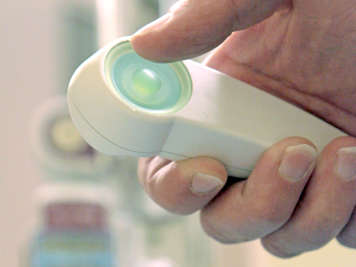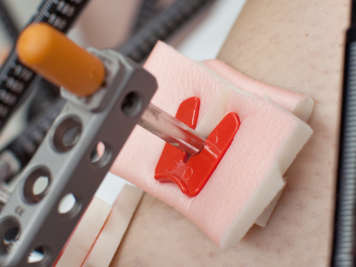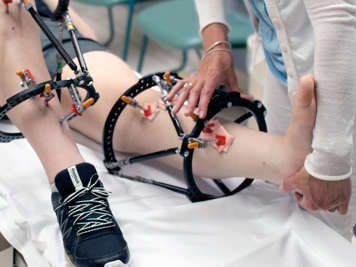What happens right after limb lengthening and reconstruction surgery?
After surgery, your child will be placed under continuous monitoring in a post-anaesthetic care unit (PACU), also known as a recovery room. Your child may be very sleepy and may not remember this time.
Once your child is settled in the recovery room, you will be able to visit them.
Soon afterwards, your child will be moved from the recovery room to the orthopaedic floor. They will stay there for the rest of their time in hospital.
How long will my child stay in hospital after limb reconstruction surgery?
Children typically stay in the hospital for three to five days after their surgery.
Can I stay with my child during their hospital stay?
You will be able to stay with your child the entire time they are in the hospital. There is a day bed for a parent in your child's room where you can sleep. If your child feels able for visitors, they can also ask their friends to come see them during visiting hours.
How will my child be monitored during their recovery from surgery?
A nurse will monitor your child after surgery while they are in the hospital. They will check your child's:
- heart rate
- breathing rate
- temperature
- blood pressure
- pain level
- fluid input and output
- pin and wire sites.
How will my child's health-care team manage my child's pain?
Many treatments are available to manage your child's pain after surgery. The options range from simple medication by mouth to stronger medication through an IV (intravenous line). Your child's surgeon will discuss your child's pain management plan with you.
Medication by mouth
Acetaminophen and other stronger medications, such as morphine, are often used for pain relief following limb reconstruction surgery. Other types of pain medication, such as anti-inflammatory drugs, ibuprofen or naproxen, may not be suitable for limb reconstruction patients because they are thought to interfere with bone healing.
Medication through an IV

If your child needs stronger medication from an IV (intravenous line), they may receive it through a patient-controlled analgesia (PCA) pump. Analgesia means pain relief. The PCA pump allows your child to control the amount of pain medication they need, but it is computerized so that your child cannot overdose.
Your child, and only your child, can press the button on the pump. It is very important that you do not try to “help” your child by pushing the button for them.
If your child uses a PCA pump, after a couple of days they will switch to medication by mouth for pain control. This way, the doctors and nurses can make sure that the pain is well controlled before your child goes home.
Localized medication
Another treatment for pain is localized medication, such as a continuous epidural infusion (a steady level of pain relief through the spinal cord) or a nerve block. These options are only used during surgery. Your surgeon and the anaesthesiologist will advise you before surgery if you should consider these options for your child.
How soon after limb reconstruction surgery will my child be able to eat?
Immediately following surgery, your child will not be able to drink or eat anything. It will take a while for their stomach to settle after the anaesthetic.
Your child will gradually tolerate more food and fluids and will work up to a full diet before going home.
Once your child is ready for fluids, it is very important that they drink as much as possible. This prevents bladder infections and helps prevent constipation.
Will my child be able to use the bathroom as usual right after surgery?
Your child may need to use a Foley catheter for a couple of days after surgery. The catheter, or tube, will drain the urine (pee) from your child's body so they will not need to go to the bathroom to urinate. A child is more likely to need a Foley catheter if they have an epidural to manage their pain.
Your child might not have a bowel movement for a few days after surgery. This is because the anaesthesia and pain medication will slow down your child's stomach and intestines. During this time, your child will likely have stomach bloating and pass a lot of gas. This is completely normal. The nurse will give your child a laxative if needed.
When will my child be able to sit up, stand and walk after surgery?
Most children will be sitting up in bed and standing on the first or second day after surgery. This is done gradually.
Your child may feel dizzy and lightheaded the first time they sit up. This is completely normal.
Your surgeon will determine how much weight your child can put on their operated limb. Most children with either a fixator will be allowed to put their full weight on the limb on the first day after surgery.
As your child adjusts to standing and moving, they will work up to short walks to the bathroom. Over the next few days, they will be able to tolerate walking longer distances, such as down the hall. Most children who have surgery feel better when they get up and move around.
How soon after limb reconstruction surgery can my child shower?
It is possible to shower after limb reconstruction surgery even if your child is wearing an external fixator. In fact, showering is encouraged as it helps keep the pin and wire sites and the fixator clean. Your child's orthopaedic surgeon will advise you when your child can begin showering. Typically this is two weeks after surgery.

How often will my child's dressing need to be changed?
If your child has an external fixator, the metal pins that fix the fixator to your child's limb have dressings on them to keep them clean. You will need to
change these dressings regularly. The dressing for the pin sites will be changed for the first time two days after surgery while your child is in the hospital. The nurse will teach you how to do further dressing changes so that you can do them at home.

How soon will my child start rehabilitation exercises after limb reconstruction surgery?
A physiotherapist will visit your child regularly during the day while staying in the hospital to go through their rehabilitation exercises. These exercises will help your child maintain the movement in their joints. They are very important in achieving an excellent result from limb reconstruction surgery. The physiotherapist will also teach your child exercises to do on their own at home between clinic visits.
The physiotherapist will assess your child's hip, knee and ankle joint range of motion to check how well your child can move. They will also help your child transfer, or move, from one position to another and help your child with bearing weight on their limb and eventually walking and using the stairs.
How can my child pass the time while they are recovering in hospital?
Many hospitals allow patients to bring in electronic devices such as phones, tablets or games consoles. Remember to store these devices safely and securely when your child is not using them.
If your child is up to it, they may also be able to take part in fun programs arranged by the hospital, such as activities in play areas or story time at the hospital library. Ask your child's health-care team if there are any such programs in the hospital where your child will have surgery.
How does my child's health-care team know when my child is ready to go home?
Your child's health care team will use the following checklist to assess your child's recovery after limb reconstruction surgery and make sure they are ready to go home. Your child can only go home when the checklist is complete.
Your child
- Is passing gas, drinking fluids and eating small amounts
- Is taking medications by mouth
- Has had their frame teaching with the physical therapy practitioner
- Has started the exercise program set by their physiotherapist
- Has obtained prescriptions for pain medication and antibiotics
Your child's health-care team
- Has done a pin and wire site dressing change and provided teaching on how to do it at home
- Has checked home safety (physiotherapist)
- Has put a plan in place for follow-up care and treatment